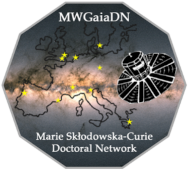Speaker
Description
JASMINE is a unique candidate for the competitive M-class Satellite Mission No. 3 at the Institute of Space and Astronautical Science (ISAS) of JAXA, whose launch is targeted for 2032. The mission has two science goals: (1) to explore the formation and evolution of the Milky Way Galaxy, and (2) to search for Earth-like exoplanets within the habitable zone. To achieve these goals, we will develop a 36 cm aperture telescope optimized for near-infrared wavelengths (0.9–1.6 $\mu$m). We are now developing a large-format (2k x 2k pixels) InGaAs imaging sensor in collaboration with a Japanese manufacturer for the mission, based on the sensor developed by the National Astronomical Observatory of Japan (NAOJ) for ground-based observations. Using these instruments, JASMINE will perform astrometric observations toward the Galactic center in spring and autumn, and transit observations of mid-M-type stars in summer and winter. The target precisions in astrometry are 40 $\mu$as for parallax and 125 $\mu$as for proper motion. Achieving these precisions requires the development of highly stable, high-performance instruments. To ensure optical stability (particularly in image distortion), the telescope will be constructed from low thermal expansion materials and operated in a temperature-controlled environment. To reduce thermal noise but to avoid mechanical disturbances, the detectors will be cooled using a combination of a radiator and Peltier devices. Precise data analysis methods are also critical to the mission’s success. We plan to use self-calibration techniques, using data collected over the three-year observation period, to model and correct image distortions. In this aspect of the mission, we are collaborating with the Gaia team as pioneers in space-based astrometry.

